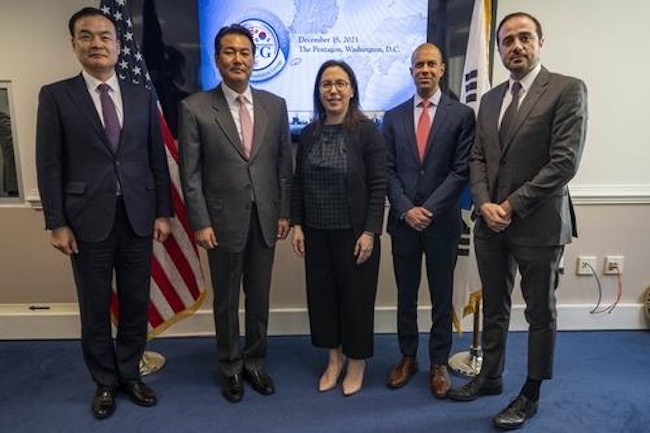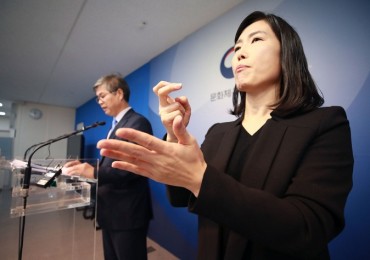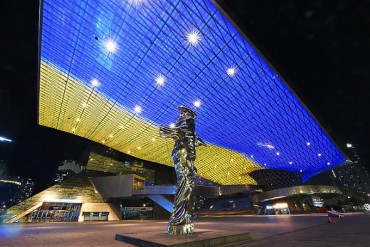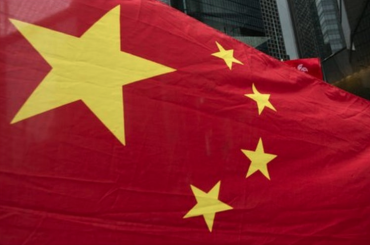
South Korean and U.S. officials pose for a photo as they attend the second session of the South Korea-U.S. Nuclear Consultative Group at the Pentagon near Washington on Dec. 15, 2023, in this photo released by South Korea’s government delegation. Among them are Principal Deputy National Security Adviser Kim Tae-hyo (2nd from L), Vipin Narang, principal U.S. deputy assistant secretary of defense for space policy (2nd from R) and Maher Bitar (R), the National Security Council coordinator for intelligence and defense policy. (Image courtesy of Yonhap)
WASHINGTON, Jan. 31 (Korea Bizwire) — The United States is monitoring the possibility of what would be North Korea’s seventh nuclear test, while working with South Korea to “effectively” manage tensions along the inter-Korean border, a senior Pentagon official has said.
Vipin Narang, principal deputy assistant secretary of defense for space policy, made the remarks in a written interview with Yonhap News Agency this week, stressing that the U.S., in tandem with South Korea, is “postured and prepared for any eventuality,” amid growing North Korean military threats.
In recent weeks, Pyongyang has exacerbated tensions through its pugnacious rhetoric against Seoul and its persistent weapons tests, including the launches of what it called a strategic cruise missile this week — provocative moves that some experts warned raised the specter of a potential war on the Korean Peninsula.
“We continue to monitor for the possibility of a seventh nuclear test in the DPRK,” he said, referring to the North by its official name, the Democratic People’s Republic of Korea. “An additional nuclear test would reinforce the irresponsible behavior of the regime and would degrade regional stability.”
Narang did not elaborate further, but his remarks came as Seoul has assessed that Pyongyang remains ready to conduct a new nuclear test “at any time,” though its timing hinges on North Korean leader Kim Jong-un’s strategic calculus.
Beefed-up military readiness aside, Narang highlighted the Pentagon’s efforts with Seoul to dial down border tensions with the North at a time when concerns have risen over the possibility of an accidental clash in the wake of Pyongyang’s exit from the Comprehensive Military Agreement (CMA).
Signed in 2018, the CMA is an inter-Korean accord designed to reduce border tensions, prevent accidental clashes and foster mutual trust. The North walked away from it following Seoul’s partial suspension of it in response to the recalcitrant regime’s space rocket launch in November.
“The United States and ROK have engaged in close cooperation to ensure we effectively manage the DPRK’s increase of tensions along the military demarcation line (MDL), including how to bolster efforts to manage and reduce military tensions with the DPRK through military de-confliction, transparency and risk reduction measures,” he said. ROK stands for the South’s official name, the Republic of Korea.
“What we need is for the DPRK to recognize that its interests are better served by de-escalating tensions than raising nuclear and military risks, which necessitates efforts by the U.S.-ROK alliance to reinforce deterrence,” he added.
Commenting on the North’s aggressive nuclear doctrine embracing preemptive strike options, Narang underlined the allies’ readiness to address the threat.
“We are postured and prepared for any eventuality in lockstep with the ROK. In particular, our strategy makes clear that dire consequences would follow the Kim regime’s use of nuclear weapons,” he said. “There is no scenario in which the Kim regime could employ nuclear weapons and survive.”

This photo from the Pentagon website shows Vipin Narang, principal deputy assistant secretary of defense for space policy. (Image courtesy of Yonhap)
Casting the North as posing a “persistent threat” and “growing danger” to the U.S. mainland, South Korea and others, he noted progress in the North’s weapons capabilities.
“North Korea continues to experience failures while conducting tests, but is also continuing to progress in diversifying and operationalizing its capabilities,” he said.
As Pyongyang’s unceasing weapons tests have underscored its quest to diversify nuclear weapon delivery platforms, Narang pointed out efforts by Seoul and Washington to strengthen combined military drills, including the Ulchi Freedom Shield (UFS) exercise.
The allies have agreed to incorporate scenarios of nuclear operations in this year’s UFS, a senior Seoul official said after the second session of the Nuclear Consultative Group (NCG), a key bilateral deterrence dialogue, in December. Narang was the Pentagon representative at the NCG meeting.
“The UFS exercise is one of the most important alliance venues for strengthening our combined defense capabilities,” he said. “We have been working, and will continue to work with the ROK to improve this and other combined exercises and training activities, including on the application of nuclear deterrence on the Korean Peninsula.”
Asked to comment on the role of the South Korea-U.S. Combined Forces Command (CFC) in a nuclear crisis, Narang said that as the “supported command” when activated, the CFC will be involved in all relevant discussions related to responding in a crisis.
The role of the CFC in a nuclear attack scenario has been called into question as the CFC, the lead command in the event of a war on the peninsula does not have the authority to manage key U.S. nuclear assets, which lies in the hands of U.S. Strategic Command.
Narang refused to comment on the envisioned guidelines on the planning and operation of a shared nuclear strategy that the allies agreed to complete by the middle of the year at the December NCG session. But he hailed the NCG as a “significant upgrade” in the two countries’ extended deterrence efforts.
Extended deterrence refers to the U.S.’ commitment to using the full range of its military capabilities, including nuclear, to defend its ally.
He brushed aside concerns about a major security impact from the North’s launch of a claimed military spy satellite.
“The DPRK’s efforts to bolster its illegal space-launch capabilities, similar to its efforts to enhance its nuclear and ballistic missile capabilities, have no effect on the ironclad nature of U.S. extended deterrence, and only serve to further strengthen the U.S.-ROK alliance as well as trilateral security cooperation with Japan,” he said.
To counter the North’s evolving threats, Narang stressed that trilateral cooperation with Japan is “essential.”
“We see enhancing trilateral cooperation with the ROK and Japan as an essential way to more effectively deter and, if necessary, respond to the DPRK’s nuclear and missile threats and to strengthen peace and stability in the Indo-Pacific,” he said.
Touching on the North’s advances in military technologies, Narang expressed concerns about cooperation between Pyongyang and Moscow.
“The DPRK is seeking new avenues to make progress on its WMD programs, which is one of the reasons we are increasingly concerned about Russian assistance to the DPRK,” he said, referring to the weapons of mass destruction.”
He also emphasized that Russia’s use of North Korean ballistic missiles in Ukraine provides “valuable technical and military insights” to the North as it seeks to perfect the capabilities of its nuclear weapon delivery systems.
“Such cooperation between the DPRK and Russia stands to strengthen the resolve of the U.S.-ROK alliance to work in concert with other like-minded countries, especially Japan and NATO allies, to address new and emerging threats in the Indo-Pacific and Europe,” he warned.
(Yonhap)






